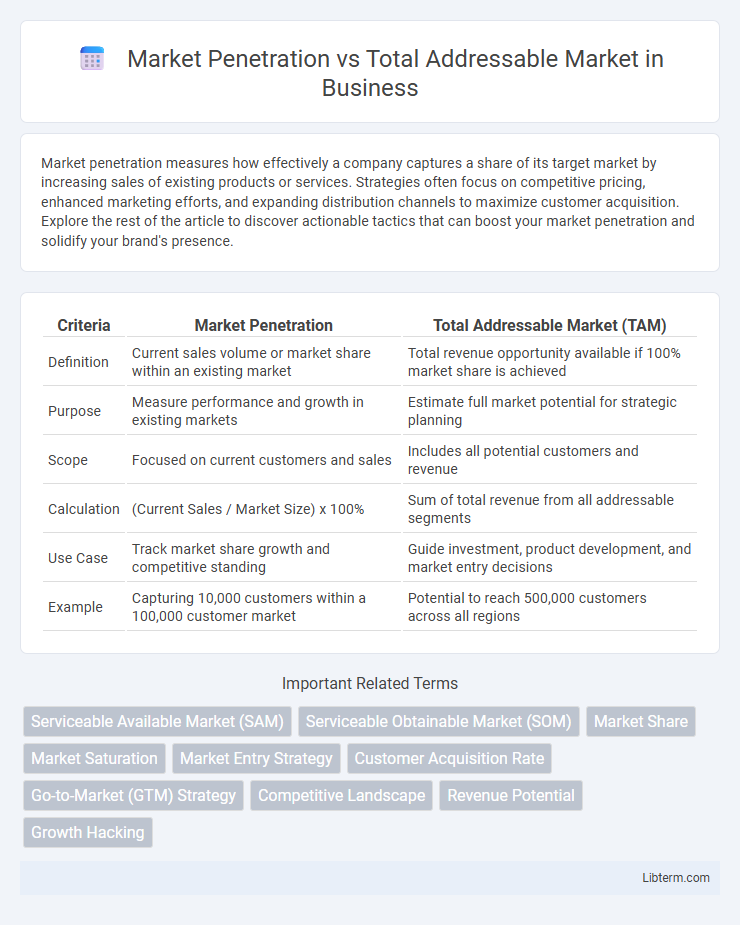Market penetration measures how effectively a company captures a share of its target market by increasing sales of existing products or services. Strategies often focus on competitive pricing, enhanced marketing efforts, and expanding distribution channels to maximize customer acquisition. Explore the rest of the article to discover actionable tactics that can boost your market penetration and solidify your brand's presence.
Table of Comparison
| Criteria | Market Penetration | Total Addressable Market (TAM) |
|---|---|---|
| Definition | Current sales volume or market share within an existing market | Total revenue opportunity available if 100% market share is achieved |
| Purpose | Measure performance and growth in existing markets | Estimate full market potential for strategic planning |
| Scope | Focused on current customers and sales | Includes all potential customers and revenue |
| Calculation | (Current Sales / Market Size) x 100% | Sum of total revenue from all addressable segments |
| Use Case | Track market share growth and competitive standing | Guide investment, product development, and market entry decisions |
| Example | Capturing 10,000 customers within a 100,000 customer market | Potential to reach 500,000 customers across all regions |
Understanding Market Penetration
Market penetration measures the percentage of a product or service's sales relative to the total addressable market (TAM), indicating how much of the potential market has been captured. A higher market penetration rate reflects strong customer adoption and effective marketing strategies within the defined market segment. Understanding this metric allows businesses to identify growth opportunities by analyzing untapped portions of the TAM and optimizing resource allocation to increase market share.
Defining Total Addressable Market (TAM)
Total Addressable Market (TAM) represents the total revenue opportunity available if a product or service achieves 100% market share within its target market. It quantifies the maximum market demand by calculating the number of potential customers multiplied by the average revenue per user. Accurately defining TAM helps businesses prioritize market strategies and allocate resources for optimal growth potential.
Key Differences Between Market Penetration and TAM
Market penetration measures the actual sales volume or revenue achieved within a specific market segment, reflecting the percentage of customers a company has reached. Total Addressable Market (TAM) represents the overall revenue opportunity available for a product or service if 100% market share is captured. Key differences include market penetration being a realized performance metric, while TAM is a theoretical maximum, guiding strategic decisions on growth potential and resource allocation.
Importance of Market Penetration Metrics
Market penetration metrics are critical for assessing the actual share a company holds within its Total Addressable Market (TAM), providing actionable insights into growth opportunities and competitive positioning. By quantifying the extent to which products or services reach target customers, these metrics enable businesses to optimize marketing strategies and allocate resources effectively. Understanding market penetration relative to TAM helps identify market gaps, forecast potential revenue growth, and drive data-driven decision making in expansion plans.
Calculating Your Total Addressable Market
Calculating your Total Addressable Market (TAM) requires identifying the entire revenue opportunity for a specific product or service within a defined market. This involves analyzing demographic data, industry reports, and customer segments to estimate the maximum potential sales if 100% market share is achieved. Accurate TAM assessment is crucial for strategic planning, forecasting growth potential, and evaluating market penetration effectiveness.
Strategies to Increase Market Penetration
Increasing market penetration involves strategies such as aggressive pricing, enhancing product quality, and expanding distribution channels to capture a larger share of the existing customer base. Leveraging targeted marketing campaigns and personalized customer engagement can significantly improve brand visibility and consumer loyalty within the Total Addressable Market (TAM). Investing in innovation and customer feedback-driven product development also supports deeper market integration, ultimately maximizing revenue potential in the defined market segment.
Leveraging TAM for Business Growth
Leveraging the Total Addressable Market (TAM) provides businesses with a clear understanding of the maximum revenue opportunity available for their products or services, guiding strategic decisions for market penetration. By accurately assessing TAM, companies can prioritize target segments, allocate resources efficiently, and identify unmet customer needs to optimize growth potential. Effective TAM analysis enables businesses to develop focused marketing campaigns and product innovations that drive deeper market penetration and sustainable expansion.
Common Mistakes in Assessing TAM and Market Penetration
Companies often miscalculate Total Addressable Market (TAM) by overestimating demand, ignoring market segmentation, or failing to account for realistic adoption rates. Market penetration mistakes typically include measuring penetration against an inflated TAM, leading to unrealistically low penetration rates, or neglecting competitive dynamics that reduce accessible market share. Accurate assessment requires rigorous data analysis, clear market definitions, and continuous updating of both TAM and penetration metrics to reflect evolving market conditions.
Case Studies: Market Penetration vs TAM in Action
Case studies highlight the dynamic relationship between Market Penetration and Total Addressable Market (TAM) by showcasing real-world examples such as Netflix's global expansion strategies and Tesla's entry into the electric vehicle market. Netflix increased market penetration by localizing content and enhancing user experience, thereby capturing a significant share of its TAM across diverse international markets. Tesla demonstrated focused market penetration within high-demand regions while continuously expanding its TAM through innovation and infrastructure development, emphasizing the strategic balance required for sustainable growth.
Choosing the Right Metric for Your Business Strategy
Market penetration measures the percentage of potential customers your business currently serves within the total addressable market (TAM), highlighting actual sales performance and market share. Total addressable market estimates the overall revenue opportunity available, guiding strategic growth and resource allocation decisions. Selecting the right metric depends on your business goals: focus on market penetration to optimize existing customer base efficiency, or prioritize TAM to plan expansion and identify new opportunities.
Market Penetration Infographic

 libterm.com
libterm.com